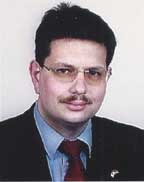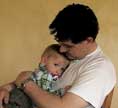 A
couple of months after Frank Sabath had joined the German Navy
for his compulsory duty in July 1986, he changed carriers to become
an officer of the naval reserve. His training as a technical officer
on mine counter measure vessels raised his interest in defense
technologies and their reliabilities. Frank graduated from the
University of Paderborn, Germany with a diploma degree (Dipl.-Ing.)
in electrical engineering.
A
couple of months after Frank Sabath had joined the German Navy
for his compulsory duty in July 1986, he changed carriers to become
an officer of the naval reserve. His training as a technical officer
on mine counter measure vessels raised his interest in defense
technologies and their reliabilities. Frank graduated from the
University of Paderborn, Germany with a diploma degree (Dipl.-Ing.)
in electrical engineering.
In 1993, Frank entered the area of EMC by joining
the analogue system-engineering group (ASE) of the C-Lab, a joint
R&D institute of the University of Paderborn, Germany, and
the Siemens Nixdorf Informationssysteme AG, Paderborn. His initial
job description included research on electromagnetic field theory,
numerical field calculation, and the development of appropriate
numerical models for the EMC analysis of a printed circuit board
(PCB). Over the years his responsibilities were complemented by
EMC analysis of PCBs and providing technical advice to industrial
customers. Frank had his first experience in a multinational team
while working on the bi-national R&D program QUELLE. In cooperation
with his project partners at the Technical University of Gdansk,
Poland and the WIDIS GmbH, Berlin, Germany he developed both methods
for radiation analysis of PCBs and material for an EMC training
course. At that time, he started giving training courses about
radiation analysis of PCBs and EMC aspects of PCB design.
During the same period he was working on his PhD thesis on “a
hybrid method for computation of the radiated field of a PCB”
under the supervision of Professor Heyno Garbe of the University
of Hanover, Germany. After having completed his PhD thesis, Frank
left the C-Lab and joined the Federal Office for Defense Technologies
and Procurement (BWB) as a civil servant. Frank spent 18 months
training in the civil service before he obtained his recent position
as a scientist at the Federal Armed Forces Research Institute
for Protective Technologies and NBC Protection (WIS) in Munster,
Germany.
Frank shifted his scope from the EMC of PCBs and subsystems to
the susceptibility and hardening of whole systems to transient
electromagnetic field threats generated by nuclear and conventional
weapons. At that time, the EMP branch started to focus on the
effects of UWB threats, both conducted and radiated. Frank and
his colleague Daniel Nitsch started studies on the susceptibility
of electronic devices to UWB field signals, protection measures
and numerical as well as analytical analysis of UWB coupling.
Due to the lack of UWB field simulators for high-power test trails
of medium and large systems, Frank investigated the theory and
design of impulse radiating antennas (IRAs) and developed the
needed UWB simulator. As a benefit of their work, Daniel Nitsch
and Frank were able to provide significant contributions toward
the German high-power microwave weapon program; both gentlemen
hold two patents for components of non-lethal weapons radiating
ultra-wide band (UWB) field signals of high magnitude.
Beside his original responsibilities, Frank was assigned as the
BWB representative in a working group on national standards for
NEMP and lightning protection of defense material. In 2002, he
became chairman of this working group. He is a member of national
and international working groups on high frequency immunity tests.
 |
| Frank (right) presenting a parachute
IRA. |
In 2002, the German armament sector decided that it should concentrate
and coordinate all activities, test centers and research institutes
dealing with EMC and electromagnetic effects. As a result, Frank
became involved in establishing a virtual center of competence
(VCC EME) that coordinates all EMC and E3 activities. This led
Frank to become one of two spokesmen chairing the VCC EME.
In the spring of 2002, Professor Jürgen Nitsch asked Frank
if he was interested in sharing his knowledge and experience with
students. Since then Frank has been a temporary lecturer at the
Otto-von-Guericke University Magdeburg, Germany, teaching theory,
design and applications of impulse radiating antennas. Based on
his teaching experience, Frank initiated an award program of the
IEEE German EMC chapter.
In 2004, Frank is collaborating with colleagues in the Surveillance
Technology Branch of the Radar Division of the US Naval Research
Laboratory as an exchange engineer under the DoD’s Engineer
and Scientist Exchange Program (ESEP).
Frank is currently involved in the organization of the European
Electromagnetic Symposium (EUROEM 2004), which is going to be
held in Magdeburg, Germany during July 12 – 16, 2004. As
the chairman of the 7th Ultra-Wide Band – Short-Pulse Electromagnetic
Conference (UWB SP 7), which is part of EUROEM 2004, he is responsible
for the creation of the technical program regarding UWB and the
edition of the UWB SP 7 book. He has assembled an active and well-experienced
team of session chairs that is willing to make the UWB SP 7 the
best of the whole EUROEM/AMEREM series. For the benefit of the
EMC Society with EUROEM 2004, Frank is organizing special events
such as a Regional chapter meeting and a Region 8 workshop on
numerical field computation. He looks forward to welcoming a large
number of EMC Society members to Magdeburg.
 |
| Frank and his son Peter. |
Frank is a senior member of the IEEE Electromagnetic Compatibility
(EMC), Antennas and Propagation (AP) and Microwaves Theory and
Techniques (MTT) Societies. He has served as the treasurer of
the German chapter of the EMCS since 2000. During his service,
he initiated an annual workshop that focuses on the discussion
of selected issues in the area of electromagnetic effects and
electromagnetic interactions.
With respect to his various activities, the EMCS Board of Directors
appointed him as the first Regional Conference Coordinator in
Region 8, encompassing Europe, Africa and the Middle East.
Frank and his wife Martina are parents of a two-year-old son Peter
and are expecting a second child in May 2004. On the personal
side, Frank is involved with several activities. He has been a
tuba player for more than 18 years. Over the years, he was with
several brass bands covering the spectrum from classical wind
music, brass bands, and swing. He is also active in his church.
EMC
 EMC
Personality Profile
EMC
Personality Profile A
couple of months after Frank Sabath had joined the German Navy
for his compulsory duty in July 1986, he changed carriers to become
an officer of the naval reserve. His training as a technical officer
on mine counter measure vessels raised his interest in defense
technologies and their reliabilities. Frank graduated from the
University of Paderborn, Germany with a diploma degree (Dipl.-Ing.)
in electrical engineering.
A
couple of months after Frank Sabath had joined the German Navy
for his compulsory duty in July 1986, he changed carriers to become
an officer of the naval reserve. His training as a technical officer
on mine counter measure vessels raised his interest in defense
technologies and their reliabilities. Frank graduated from the
University of Paderborn, Germany with a diploma degree (Dipl.-Ing.)
in electrical engineering.
